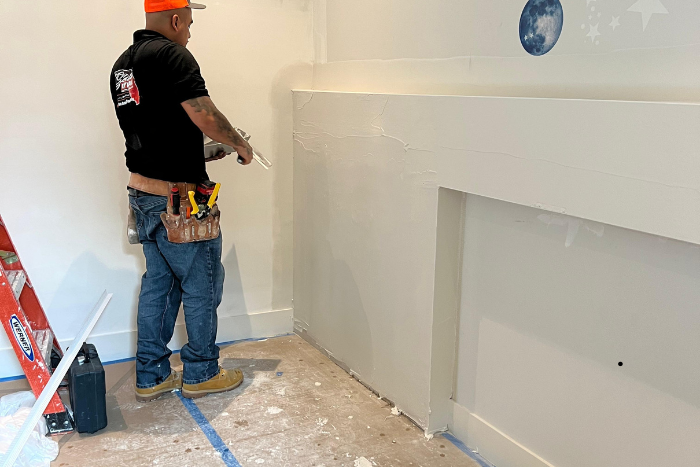Fixing holes and cracks in your walls can seem like a big job. But don’t stress! It’s not as hard as it sounds. If you’re new to wall patching, this guide will walk you through everything you need to know. Trust me, with the right tools and a little patience, you can fix up your walls like a pro. So, let’s dive in!
What’s Wall Patching and Refinishing, Anyway?
First off, what exactly are we talking about here? Wall patching is simply fixing holes, cracks, or any damage in your walls. Refinishing, on the other hand, is the process of making your walls smooth and fresh again. When you patch a wall, you are getting it ready for refinishing. Think of it like preparing a canvas for painting.
Now, wall patching is easy to learn, even for beginners. You don’t have to be a professional to fix up a wall. All you need is a little practice, and you’ll get the hang of it quickly. If you want to dig deeper into the world of wall repair, check out a drywall repair guide. It’ll give you some more expert tips!
Common Wall Problems and How to Fix Them
Walls aren’t perfect. They crack, dent, and sometimes even get big holes. It happens. But don’t worry. Each problem has an easy fix. Let’s look at the most common wall issues and how to handle them.
- Holes
Holes are probably the biggest issue you’ll deal with. They happen for all sorts of reasons. A doorknob hits the wall, furniture bumps into it, or maybe you just accidentally punched it. Small holes are easy to fix. Larger ones take a little more time but don’t worry, you can handle it.
- Cracks
Cracks show up for different reasons. Sometimes, your house just settles over time, and cracks appear. The temperature change can also cause them. You’ll often find cracks near windows or doors. While cracks seem like a big deal, they’re pretty easy to fix if you catch them early.
- Dents
Dents happen when something hard hits the wall. It could be anything—a heavy object or even a chair leg. Dents are trickier to spot than holes, but they can still be fixed with a little effort.
Tools You’ll Need for the Job
Okay, now let’s talk tools. You don’t need anything fancy, just a few basics. But don’t skip this part! Having the right tools will make your job way easier. Here’s a quick list:
- Spackling paste or joint compound: This is what fills the holes and cracks. The consistency of the paste will depend on the size of the damage.
- Putty knife: Use this to spread the compound smoothly. It comes in different sizes, so pick one that works best for your job.
- Sandpaper: You’ll need this to smooth everything out once it’s dry. A fine grit works best.
- Primer and paint: After you patch the walls, you’ll need to prime and paint to make everything blend.
- Caulk gun (optional): If you’re working with cracks, you might want a caulk gun to fill them up quickly.
How to Patch Walls Step by Step
So, you’ve got your tools. Now let’s get to work! Don’t worry. It’s easy once you break it down into steps.
Step 1: Clean the Area
Before you even think about patching, make sure the area is clean. Wipe down the wall with a damp cloth. Dust, dirt, and old paint can make the patching process harder. So, start fresh!
Step 2: Prepare the Damage
For holes, grab a utility knife and cut away any loose edges. You want to make sure the edges of the hole are clean so the compound sticks. For cracks, you’ll need to widen them a little. Sounds strange, but it helps the filler adhere better.
Step 3: Apply the Compound
Now, grab your putty knife and start applying the joint compound. Press it into the hole or crack. Smooth it out as best as you can. You don’t want a thick layer, just enough to fill in the damage. Don’t worry if it’s a bit messy. We’ll clean that up soon!
Step 4: Let It Dry
Here’s where patience comes in. Let the compound dry. It usually takes a few hours, but check the instructions on your product. You don’t want to rush this step.
Step 5: Sand It Smooth
Once the compound is dry, take your sandpaper and start smoothing it out. Go gently so you don’t make the patch uneven. You’re aiming for a smooth finish, just like the rest of the wall. For a more even look, try sanding in circles.
Step 6: Apply More Compound if Needed
If the hole or crack is still visible after one layer, don’t panic. Just add another thin coat of compound. Let it dry, sand it again, and repeat until it’s smooth.
Step 7: Prime and Paint
Once everything is smooth and dry, it’s time to prime. Apply a coat of primer to help the paint stick. Once the primer dries, paint the patched area. You might need two coats of paint to make it blend seamlessly with the rest of the wall.
Texture Repair: When and How to Fix Textured Walls
Not all walls are smooth. Some have textures like popcorn ceilings or orange peel patterns. If your walls have texture, you’ll need to replicate that after patching. That’s where texture repair comes into play.
How to Repair Different Textures
Here are some ways to fix common wall textures:
- Knockdown Texture: After patching the wall, use a texture spray. Wait a few minutes, then use a drywall knife to flatten the peaks. This creates the typical knockdown look.
- Popcorn Texture: Fixing popcorn ceilings is a bit trickier. You’ll need to use a texture spray to recreate the pattern. Be sure to protect the area around you from splatter.
- Orange Peel Texture: Orange peel texture is common on walls. Use a texture sprayer or roller to apply a thin layer. Once it dries, you’ll have that unique orange peel look.
Each texture needs different tools and techniques, but it’s all doable. Just take your time and follow the steps.
Pro Tips for a Smooth, Professional Finish
Want your wall patching to look like a pro did it? Here are a few tips to make sure it’s smooth and seamless.
- Don’t Rush It: Speeding through the process is a mistake. Each step needs time to dry and set. Patience is key!
- Use Thin Layers: Apply thin coats of compound. It’s easier to add more if needed than to fix a thick mess.
- Clean While Sanding: Dust from sanding can make things look rough. Wipe the patched area down with a damp cloth to remove any dust.
Wrapping It Up
Patching and refinishing walls isn’t as hard as it seems. It just takes a little practice and patience. Whether you’re fixing small holes or large cracks, follow these steps, and you’ll be left with smooth, flawless walls.


